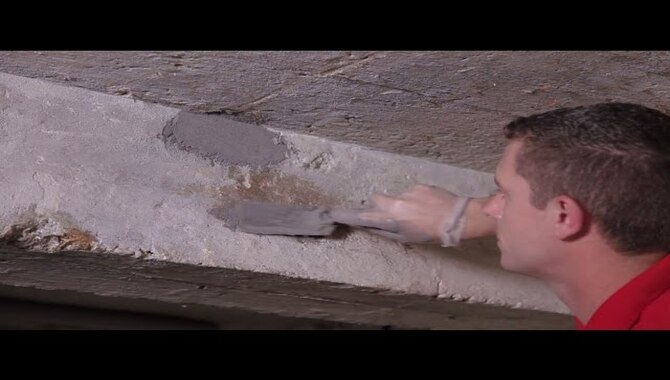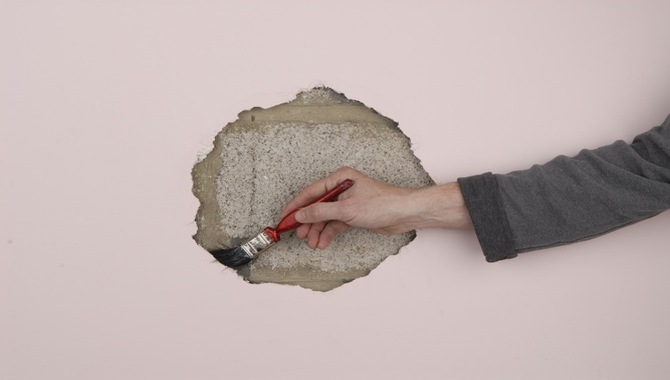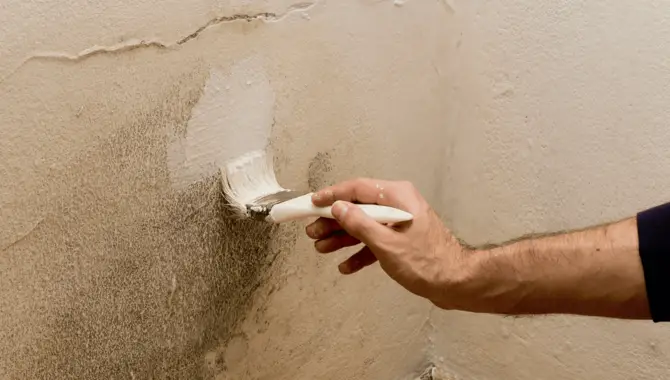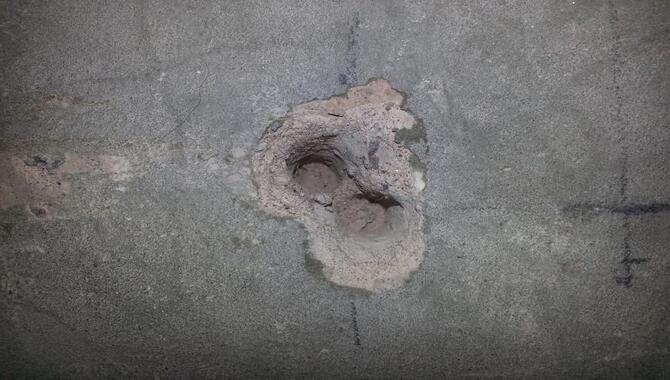Concrete walls are popular for commercial and residential properties due to their durability and strength. We have given you some steps on How to fill holes in concrete walls.
Even the sturdiest of concrete walls can develop holes over time due to damage or natural wear and tear. These unsightly gaps can negatively impact the aesthetic appeal of your property and pose a potential safety hazard if left unaddressed. Fortunately, filling holes in concrete walls is a relatively simple and straightforward process that can be achieve with the right tools and techniques.

Tools To Fill Holes In Concrete Walls

- Trowel: A flat-bladed tool for applying and smoothing the concrete patching material into the hole.
- Wire brush: Helps clean the hole and remove loose debris before applying the patching material.
- Chisel: Remove any loose or crumbling concrete around the hole.
- Hammer: Paired with the chisel, it helps break away any damaged concrete around the hole.
- Vacuum or brush: Useful for cleaning the hole and removing dust and debris before applying the patch.
- Concrete bonding agent: A liquid adhesive that enhances the bond between the existing concrete and the patching material.
- Patching compound: Specifically designed for repairing and filling holes in concrete, these compounds come in various formulations (e.g., vinyl, epoxy, latex-based).
- Putty knife: Used to apply and smooth the patching compound into the hole.
- Sandpaper: Helps smooth the patched area once it has dried.
- Paint or sealant: Applied after the patched area has dried to match the color and texture of the surrounding concrete wall.
How To Fill Holes In Concrete Walls: By Following 9 Bellow Guideline

01. Prepare The Area
Looking to fill holes in concrete walls, the first step is to prepare the area. Start by thoroughly cleaning the hole and its surrounding area, removing any dirt or debris that may have accumulated. This will ensure that the patching material adheres well to the surface.
Once the area is clean, use a wire brush to roughen the edges of the hole. This will help the patching material bond to the existing concrete surface. Once the area is prepped, it’s time to fill the hole. Begin by mixing the patching material according to the manufacturer’s instructions.
This will typically involve adding water to a dry mix and stirring until it forms a thick, smooth paste. Then, using a putty knife or trowel, carefully apply the patching material into the hole, making sure to fill it completely. Smooth the surface of the patch with the putty knife or trowel, ensuring that it is flush with the surrounding concrete.
02. Remove Loose Concrete
If you have concrete walls with holes or cracks, it’s important to address them to prevent further damage. Before filling the holes, it’s important to remove any loose concrete from the area. This done by using a chisel and hammer to break away any loose pieces, or a wire brush to clean the surface.
Once you’ve removed all the loose concrete, you can begin to fill the holes.To fill small holes, you can use a concrete patching compound or a two-part epoxy. For larger holes or cracks, you may need to use a cement mix.
It’s important to follow the manufacturer’s instructions for mixing and applying the product. When applying the patching compound or cement mix, make sure to fill the hole or crack completely. Use a trowel to smooth out the surface and blend it with the surrounding concrete. Allow the patch to dry completely before painting or sealing the surface.
03. Clean The Hole
If you’re looking to repair a hole in a concrete wall, the first step is to ensure the area is clean and free of debris. Start by removing any loose concrete and dust from the hole, using a wire brush or vacuum cleaner. If the hole is deep, you may need to use a chisel or hammer and chisel to remove any remaining debris. Once the area is clean, you can begin filling the hole.There are a variety of products available for filling holes in concrete walls, such as epoxy or cement-based fillers.
Before selecting a product, ensure that it is suitable for the size and depth of the hole, as well as the type of concrete you are working with.To fill the hole, mix the product according to the manufacturer’s instructions and use a trowel to apply it to the area. Make sure the product is spread evenly and fills the entire hole.
04. Apply A Bonding Agent

If you’re looking to fill holes in a concrete wall, thet step is to apply a bonding agent. This is an important step as it helps to ensure the new material will adhere properly to the existing concrete. Once you have applied the bonding agent, you can begin filling the holes. One option is to use a concrete patching material, which can be applied to the hole with a putty knife.
It’s important to follow the manufacturer’s instructions and to work quickly, as the material will begin to harden within a few minutes. Another option is to mix a batch of concrete yourself and use it to fill the holes. To do this, you’ll need to mix the concrete according to the instructions on the bag, and then use a trowel to apply it to the holes. Again, it’s important to work quickly to ensure the material sets properly.
05. Prepare The Patching Compound
When it comes to filling holes in concrete walls, one step is to prepare the patching compound. This can be done by mixing a concrete patching compound with water until it reaches a thick, creamy consistency. Make sure to follow the instructions on the package to ensure that the mixture is properly blended. Once the compound is ready, use a putty knife or trowel to apply it to the hole, making sure to fill it completely. Smooth out the surface of the patch with the putty knife, and allow it to dry for several hours.
Once the patch is dry, you can sand it down and paint over it to match the color of the surrounding concrete. It’s important to note that the success of the patching job will depend on the size and severity of the hole, as well as the quality of the patching compound used. For larger holes or cracks, it may be necessary to use a more high-strength patching compound or to seek professional assistance.
06. Fill The Hole

Concrete walls are a popular choice for construction due to their durability and strength. over time, these walls can develop holes due to various reasons such as wear and tear, weather conditions, or improper installation. Filling these holes is crucial to prevent further damage and maintain the integrity of the wall. But how do you fill the hole in a concrete wall? clean the hole thoroughly to remove any debris or loose concrete particles. Then, prepare the concrete mix according to the manufacturer’s instructions.
You can also add some water-resistant additives for added durability. Using a trowel or putty knife, apply the mix to the hole in layers, ensuring that each layer is compacted and smoothed out before adding the next. Continue until the hole is filled, and the mix is level with the surface of the wall.
07. Smooth The Surface
Filling holes in concrete walls can be a challenging task. with the right tools and techniques, you can achieve a smooth surface. The first step is to clean the surface thoroughly and remove any loose debris. Next, you will need to choose an appropriate filler material. Depending on the size and depth of the hole, you can use a cement-based filler or an epoxy resin. Mix the filler material according to the manufacturer’s instructions and apply it to the hole using a putty knife.
It’s important to work quickly and ensure that the filler material is evenly sprea. Once the hole is filled, allow the filler material to dry completely. After the filler has dried, you can use sandpaper to smooth the surface and remove any excess filler. It’s important to ensure that the surface is level and free from any bumps or lumps. If necessary, repeat the process to achieve a smooth surface.
08. Sand The Patched Area
If you need to fill holes in concrete walls, there are a few steps you can follow to get the job done right. First, you’ll need to clean the area around the hole, removing any debris or loose concrete. Next, you’ll want to use a concrete patching compound to fill the hole, following the instructions on the packaging carefully.
Once the compound is dry, you can sand the patched area to smooth it out and ensure a seamless finish. When sanding, it’s important to wear protective gear, such as a mask and goggles, to avoid inhaling any dust or debris.
You may also want to use a sanding block or sandpaper to get the best results. After sanding, you can paint or apply a finish to the patched area to match the surrounding concrete. Overall, filling holes in concrete walls is a relatively simple process, but it’s important to take your time and follow the steps carefully to ensure a successful outcome.
09. Paint Or Seal The Area

If you need to fill holes in your concrete walls, there are a few steps to follow to make sure the repair is effective and long-lasting. First, clean the area around the hole thoroughly, removing any loose pieces of concrete or debris. Next, use a concrete patching compound to fill the hole, following the instructions carefully to ensure proper mixing and application.
Depending on the size of the hole, you may need to apply the compound in layers, allowing each layer to dry before adding the next. Once the hole is filled, use a trowel to smooth the surface and ensure it is level with the surrounding area.
Finally, you may want to paint or seal the area to provide additional protection against moisture or other environmental factors that could compromise the repair. It’s important to note that the process of filling holes in concrete walls can be more complicated if the wall is load-bearing or otherwise structurally important.
The Benefit Of Fill Holes In Concrete Walls
Filling holes in concrete walls can offer numerous benefits, both practical and aesthetic. One of the most significant benefits is the enhanced structural integrity of the wall. Holes in concrete walls can weaken the wall’s overall strength, making it more susceptible to damage from external forces.

Filling these holes with the appropriate materials can help to restore the wall’s original strength and ensure that it can withstand any unforeseen stresses. Another benefit of filling holes in concrete walls is the improved appearance of the wall.
Holes in concrete walls can be unsightly and detract from the overall aesthetic of a space. By filling these holes, the wall can be restored to its original appearance, creating a more cohesive and visually appealing environment. Filling holes in concrete walls can also help to improve the insulation properties of the wall. Holes in the wall can allow air to seep through, leading to temperature fluctuations and increased energy consumption.
Conclusion:
Filling holes in concrete walls can seem daunting at first, but with the right tools and techniques, it can be a relatively simple process. we already give you How to fill holes in concrete walls. you can ensure that your concrete walls are not only functional but also aesthetically pleasing.
Remember to always wear protective gear and use caution when working with concrete. If you are unsure about your ability to complete the task, it is always best to consult a professional. With a little bit of effort and attention to detail, you can repair your concrete walls and enjoy a safe and visually pleasing environment for years to come.
Faq:
What Is The Best Material To Use For Filling Holes In Concrete Walls?
The best material to use for filling holes in concrete walls is a concrete patching compound or hydraulic cement. These materials are specifically designed to adhere to concrete surfaces and provide a durable, long-lasting repair.
How Do You Prepare The Surface Of The Concrete Wall Before Filling In The Holes?
To prepare the surface of the concrete wall before filling in the holes, you should first clean the area around the holes with a wire brush and remove any loose debris or dust.
Can You Use Regular Spackle Or Putty To Fill In Holes In A Concrete Wall?
No, regular spackle or putty is not suitable for filling holes in a concrete wall. Concrete requires a specific type of filler or patching compound designed for use on masonry surfaces.
How Long Does It Take For The Filler Material To Dry And Harden In The Holes?
The answer to this question depends on the specific type of filler material being used. Some filler materials may dry and harden within a few hours, while others may take several days to fully cure.
Are There Any Special Equipment Needed To Fill In Holes In Concrete Walls?
Yes, special equipment is needed to fill in holes in concrete walls. This includes a drill with a masonry bit to create a clean hole, a trowel or putty knife to apply the patching material, and a concrete patching compound to fill in the hole.

I am passionate about tools and electric work. I love finding new tools and experimenting with them.
